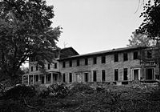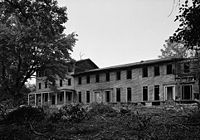
Phalanstère
Encyclopedia
A phalanstère was a type of building designed for an utopian community
and developed in the early 19th century by Charles Fourier
. Based on the idea of a phalanx
, this self-contained community ideally consisted of 1500-1600 people working together for mutual benefit. Though Fourier published several journals in Paris, among them La Phalanstère, he created no phalanstères in Europe
due to a lack of financial support. Several so-called colonies were founded in the United States of America by Albert Brisbane
and Horace Greeley
.
Fourier believed that the traditional house was a place of exile and oppression of women. He believed gender roles could progress by shaping them within community, more than by pursuits of sexual freedom or other Simonian
concepts.
 Charles Fourier
Charles Fourier
conceived the phalanstère as an organized building designed to integrate urban and rural features.
The structure of the phalanstère was composed by three parts: a central part and two lateral wings. The central part was designed for quiet activities. It included dining rooms, meeting rooms, libraries and studies. A lateral wing was designed for labour and noisy activities, such as carpentry, hammering and forging. It also hosted children because they were considered noisy while playing. The other wing contained a caravansary, with ballrooms and halls for meetings with outsiders. The outsiders had to pay a fee in order to visit and meet the people of the Phalanx community. This income was thought to sustain the autonomous economy of the phalanstère. The phalanstère also included private apartments and many social halls. A social hall was defined by Fourier as a seristère.
Fourier's successor Victor Considerant compared the idea of the phalanstère to a steamship, asking whether it was "easier to house 1800 men right in the middle of the ocean, six hundred leagues from every shore,...than to house in a unitary construction some 1800 good peasants in the heart of Champagne or firmly on the soil of Beauce?"
In the 20th century, the architect Le Corbusier
adapted the concept of the phalanstère when he designed the Unité d'Habitation
, a self-contained commune, at Marseilles.
Utopia
Utopia is an ideal community or society possessing a perfect socio-politico-legal system. The word was imported from Greek by Sir Thomas More for his 1516 book Utopia, describing a fictional island in the Atlantic Ocean. The term has been used to describe both intentional communities that attempt...
and developed in the early 19th century by Charles Fourier
Charles Fourier
François Marie Charles Fourier was a French philosopher. An influential thinker, some of Fourier's social and moral views, held to be radical in his lifetime, have become main currents in modern society...
. Based on the idea of a phalanx
Phalanx formation
The phalanx is a rectangular mass military formation, usually composed entirely of heavy infantry armed with spears, pikes, sarissas, or similar weapons...
, this self-contained community ideally consisted of 1500-1600 people working together for mutual benefit. Though Fourier published several journals in Paris, among them La Phalanstère, he created no phalanstères in Europe
Europe
Europe is, by convention, one of the world's seven continents. Comprising the westernmost peninsula of Eurasia, Europe is generally 'divided' from Asia to its east by the watershed divides of the Ural and Caucasus Mountains, the Ural River, the Caspian and Black Seas, and the waterways connecting...
due to a lack of financial support. Several so-called colonies were founded in the United States of America by Albert Brisbane
Albert Brisbane
Albert Brisbane was an American utopian socialist, the chief popularizer of the theories of Charles Fourier in the United States in several books, notably Social Destiny of Man , and in his Fourierist journal The Phalanx...
and Horace Greeley
Horace Greeley
Horace Greeley was an American newspaper editor, a founder of the Liberal Republican Party, a reformer, a politician, and an outspoken opponent of slavery...
.
Fourier believed that the traditional house was a place of exile and oppression of women. He believed gender roles could progress by shaping them within community, more than by pursuits of sexual freedom or other Simonian
Claude Henri de Rouvroy, comte de Saint-Simon
Claude Henri de Rouvroy, comte de Saint-Simon, often referred to as Henri de Saint-Simon was a French early socialist theorist whose thought influenced the foundations of various 19th century philosophies; perhaps most notably Marxism, positivism and the discipline of sociology...
concepts.
The phalanstère structure

Charles Fourier
François Marie Charles Fourier was a French philosopher. An influential thinker, some of Fourier's social and moral views, held to be radical in his lifetime, have become main currents in modern society...
conceived the phalanstère as an organized building designed to integrate urban and rural features.
The structure of the phalanstère was composed by three parts: a central part and two lateral wings. The central part was designed for quiet activities. It included dining rooms, meeting rooms, libraries and studies. A lateral wing was designed for labour and noisy activities, such as carpentry, hammering and forging. It also hosted children because they were considered noisy while playing. The other wing contained a caravansary, with ballrooms and halls for meetings with outsiders. The outsiders had to pay a fee in order to visit and meet the people of the Phalanx community. This income was thought to sustain the autonomous economy of the phalanstère. The phalanstère also included private apartments and many social halls. A social hall was defined by Fourier as a seristère.
Fourier's successor Victor Considerant compared the idea of the phalanstère to a steamship, asking whether it was "easier to house 1800 men right in the middle of the ocean, six hundred leagues from every shore,...than to house in a unitary construction some 1800 good peasants in the heart of Champagne or firmly on the soil of Beauce?"
In the 20th century, the architect Le Corbusier
Le Corbusier
Charles-Édouard Jeanneret, better known as Le Corbusier , was a Swiss-born French architect, designer, urbanist, writer and painter, famous for being one of the pioneers of what now is called modern architecture. He was born in Switzerland and became a French citizen in 1930...
adapted the concept of the phalanstère when he designed the Unité d'Habitation
Unité d'Habitation
The Unité d'Habitation is the name of a modernist residential housing design principle developed by Le Corbusier, with the collaboration of painter-architect Nadir Afonso...
, a self-contained commune, at Marseilles.
See also
- Feminism in FranceFeminism in FranceFeminism in France has its origins in the French Revolution. A few famous figures emerged during the 1871 Paris Commune, including Louise Michel, Russian-born Elisabeth Dmitrieff, Nathalie Lemel, and Renée Vivien .-French Revolution:...
- Oyasato-yakataOyasato-yakataThe oyasato-yakata complex is a collection of buildings in Tenri City, Nara, Japan. that form an incomplete square on each side surrounding the Divine Residence , a structure sacred to the Japanese new religion Tenrikyo...
- Kibbutzim

